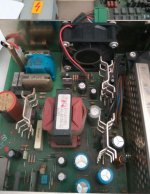anormal
Experienced Member
I got a Olivetti PCS86, standard model, 720KB 3.5 floppy, internal Conner 20MB HD (CONNER CP3026, a Olivetti rebrand of more usual CP3024).
I am thinking about upgrading it, a SB 16, a 5.25 floppy (a 360k, for testing and copying old floppies), exchanging the 720kb for 1.44MB one (i've read the jumper's config in seasip.info page) and...
...well, the HD has bad surface, errors reading it, boots ok, but for example running WordPerfect 5.1 (installed in the machine) reports error reading files.
I currently have it running Spinrite 5.0, 6.0 hangs because this model has a Nec v30 processor (8086), and it seems 6.0 needs a 286. It surprised me, because i thought Spinrite was robust coded, it could check for less than 286 processor and report it instead of hanging up, anyway...)
Spinrite 5.0 is doing its "supossely" magic, in fact i do it for the fun. It says 500h remaining...And just testing surface, not using "recover" bad sectors...
Well, a new HD is the way. This model has a integrated IDE controllers as I read. Even when this HD seems to be XTA instead of ATA? (but i've read in Seagate reference manual, it's ATA)...
My question, is modern IDE could work?. For modern I am thinking a 120MB of the 90s or so... I think i have some of them in a box. The other idea is using a conversor.
As i think, i don't need a XTIDE? as this model has already a ide controller (apart from xtide being much better, faster, etc...) Do you think a SD to IDE card conversor (40 pins) would work? I can find it for pennies in internet.
Any other ideas about upgrading the HD in this model?
Thanks for your time gentlemen.
Edit, i forgot about the 2 free simms slot in the motherboard. They work as EMS, read it somewhere... Worth effort? I've read similar questions here, but not found definitive answer.
I am thinking about upgrading it, a SB 16, a 5.25 floppy (a 360k, for testing and copying old floppies), exchanging the 720kb for 1.44MB one (i've read the jumper's config in seasip.info page) and...
...well, the HD has bad surface, errors reading it, boots ok, but for example running WordPerfect 5.1 (installed in the machine) reports error reading files.
I currently have it running Spinrite 5.0, 6.0 hangs because this model has a Nec v30 processor (8086), and it seems 6.0 needs a 286. It surprised me, because i thought Spinrite was robust coded, it could check for less than 286 processor and report it instead of hanging up, anyway...)
Spinrite 5.0 is doing its "supossely" magic, in fact i do it for the fun. It says 500h remaining...And just testing surface, not using "recover" bad sectors...
Well, a new HD is the way. This model has a integrated IDE controllers as I read. Even when this HD seems to be XTA instead of ATA? (but i've read in Seagate reference manual, it's ATA)...
My question, is modern IDE could work?. For modern I am thinking a 120MB of the 90s or so... I think i have some of them in a box. The other idea is using a conversor.
As i think, i don't need a XTIDE? as this model has already a ide controller (apart from xtide being much better, faster, etc...) Do you think a SD to IDE card conversor (40 pins) would work? I can find it for pennies in internet.
Any other ideas about upgrading the HD in this model?
Thanks for your time gentlemen.
Edit, i forgot about the 2 free simms slot in the motherboard. They work as EMS, read it somewhere... Worth effort? I've read similar questions here, but not found definitive answer.




